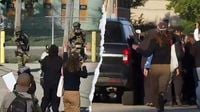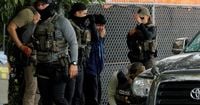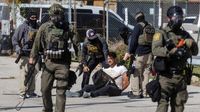On Friday, September 26, 2025, the usually quiet suburb of Broadview, Illinois, found itself at the center of a national firestorm. Federal agents with U.S. Immigration and Customs Enforcement (ICE) and hundreds of protesters clashed outside the Broadview Processing Center, resulting in scenes that many residents and officials described as nothing short of chaos. The confrontations have ignited fierce debate over immigration enforcement, protest rights, and the boundaries of federal authority in local communities.
According to The Associated Press, the trouble began early in the morning as more than 200 protesters gathered at the gates of the ICE facility, with another 30 attempting to access a different entrance. The protest, one of several in recent weeks, was met with a forceful response from federal agents, who deployed tear gas, pepper spray, mace, and rubber bullets in an attempt to disperse the crowd. The escalation was swift and, for many, unexpected. "We literally were just tying notes on the wall, and for a minute, I was obviously coughing. It was very hard to breathe," said Bushra Amiwala, a Skokie Board of Education member who was among those caught off guard by the chemical agents. "I was disoriented for a second. I just didn’t understand what happened."
Federal agents, some reportedly firing from rooftops, did not limit their tactics to chemical agents. Protesters, journalists, and even local officials described being struck by rubber pellets. The Chicago Sun-Times reported that one of its photographers was hit, while CBS News Chicago captured the moment a protester was shot with a pepper ball simply for touching the facility’s fence. Army veteran Victor Sarmiento, who served in Afghanistan, said he was filming agents on the roof when his phone was shot by a pepper ball. "The Army has taught me, when you see something wrong, you speak up. You not only defend yourself, but you defend others," Sarmiento reflected. "But coming back, it's sad that this is happening here at home. They're dressed up in combat gear. It's not needed here. Combat gear is needed in Afghanistan, Iraq, or where else the military sends us. So it's sad that they're out here terrorizing people."
For Broadview Mayor Katrina Thompson, the events were the last straw. In a pointed letter to ICE Field Office Director Russell Hott, she condemned the agency’s tactics. "In effect, you are making war on my community," she wrote. "And it has to stop." Thompson’s plea was not just rhetorical. She detailed how Broadview’s own police officers and firefighters had been sidelined due to exposure to tear gas, and how residents were flooding Village Hall with calls for help. She also demanded that ICE remove a fence hastily constructed around the facility after previous protests—one that Broadview’s fire chief said was illegally built without a permit and impeded emergency response. "Beleaguered Broadview residents are begging for relief from your center’s siege of our neighborhood," Thompson said, emphasizing the toll on both first responders and ordinary citizens.
The Department of Homeland Security (DHS) offered a starkly different account. In official statements, including one from Assistant Secretary Tricia McLaughlin, DHS described the gathering as a riot, not a protest. "Just days after the vile terrorist attack on an ICE Dallas Facility, over 200 rioters gathered outside the Broadview Processing Center in Illinois, and some began chanting ‘shoot ICE.’ These violent threats and smears about ICE must stop. There is no place in American politics for violence," McLaughlin declared. DHS claims that rioters arrived equipped with fireworks, N-95 masks, gas masks, goggles, knee and elbow protection, and large quantities of food and water. They also allege that protesters have thrown rocks, fireworks, and slashed tires, resulting in a more than 1,000% increase in assaults on ICE officers since the start of what they call "Operation Midway Blitz."
Law enforcement arrested at least two protesters on Friday, one of whom, Elias Cepeda, was reportedly carrying a firearm. Cepeda, a community leader from Pilsen and licensed to carry a concealed weapon, was said by colleagues to have been attempting to deescalate tensions. His mother, Leila Mendez, described him as "like a gentle giant," and his supporters expect him to be released without federal charges. In total, DHS says 17 protesters have been arrested in Broadview since September 19 on charges ranging from trespassing to carrying firearms.
Political leaders have not shied away from weighing in. U.S. Rep. Delia Ramirez, along with Senators Dick Durbin and Tammy Duckworth, called for an urgent meeting with ICE leadership to discuss what they described as "pressing matters," including the ongoing operation and conditions at the Broadview facility. Meanwhile, DHS publicly called on Illinois Governor J.B. Pritzker and Chicago Mayor Brandon Johnson to condemn what it characterized as riots and threats against ICE law enforcement. The agency accused local politicians of "villainizing and demonizing ICE law enforcement," pointing to comments by Pritzker likening the U.S. to "Nazi Germany" and Johnson referring to ICE as "secret police" that "are terrorizing our communities."
Inside the brick walls of the Broadview facility, the situation is no less fraught. According to advocates like Erendira Rendón of The Resurrection Project, as many as 200 people are held at a time, some for up to five days, with minimal food, water, and access to medication. Communication with the outside world, including attorneys, is limited. "It’s a black hole," Rendón said. "You can’t call the center. You can’t talk to anybody." The Department of Homeland Security, for its part, denies these allegations, insisting that detainees are only "briefly processed" before being transferred elsewhere.
The standoff has drawn a diverse array of voices. Some protesters, like Mary Gearing, expressed disbelief at the escalation: "Just standing here with signs peacefully, to be fired at with pepper spray is just like unconscionable, I can't even believe this is happening." Others, like supporters of ICE who showed up to counter-protest, insisted that the agency is unfairly maligned. "I'm not anti-immigrant, I'm anti-crime, and that's why I'm here supporting these guys," said Edward Anthony, who blamed local and state officials for what he called a "bad rap" against ICE.
As dusk settled on Broadview, the tension had not dissipated. Protesters continued to try to block ICE vehicles, while federal agents maintained a heavy presence. The fence remained, a symbol of the divide—both literal and figurative—between federal authority and local outrage. For now, the only certainty is that the debate over immigration enforcement and protest rights will continue to play out, not just in Broadview, but across the country.
While the dust may settle temporarily, the questions raised about civil liberties, public safety, and the role of federal agencies in local communities demand answers that neither side seems ready to concede. The events in Broadview serve as a stark reminder of the deep divides—and the very real human consequences—at the heart of America’s immigration debate.


